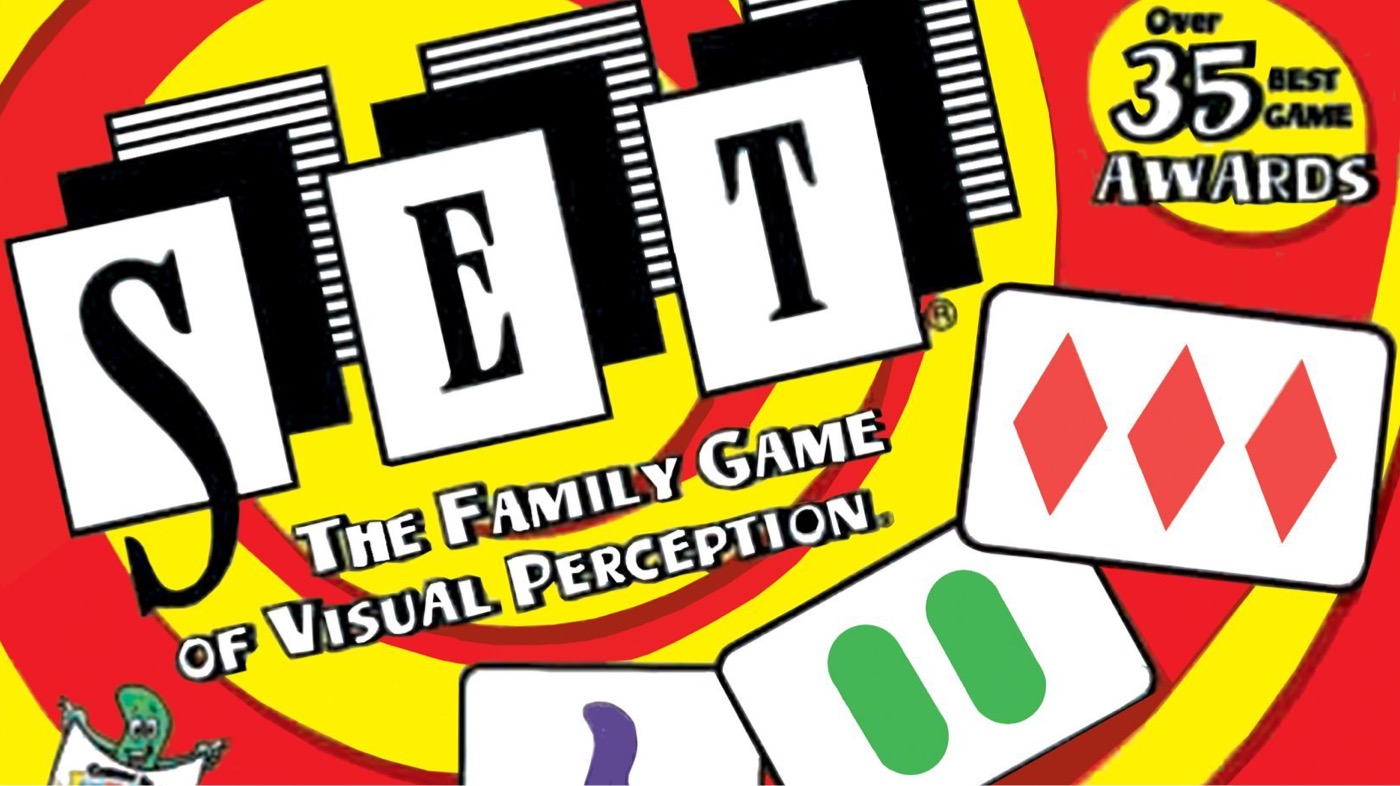Just over a week ago I shared one of my favourite mathematical puzzles. Today I’m sharing my favourite mathematical game, SET. There is something in this game for young children to mathematics professors. I give SET workshops each year, for Year 8 students up. My slides are here, along with some notes I wrote several years ago. I suggest at least 90 minutes. A brief outline, along with some interesting questions, is below.
SET is a card game. There are four attributes of a SET card. The three cards below show all possible values of the attributes.

If a SET deck contains exactly one card of every possible combination of attributes, how many cards are in a deck?
A SET is a group of three cards where, for each of the four attributes, the features are the same across all three cards or different across all three cards. The three cards below are a SET because shape is all-same, fill is all-same, number is all-different, colour is all-different.

If two cards are selected at random from the deck, how many cards, if any, can be paired with the first two to complete the SET?
How many SETs are possible (including those where a card is used in more than one SET) among all cards in the deck?
To play SET with others, lay twelve cards out on the table. The first person to find a SET calls ‘SET’, shows it to the rest of the players. The empty spaces are then replenished from the deck. If the players agree that there is no SET on the table, three more cards are dealt. At the end of the game, the person with the most SETs wins.
Many interesting questions arise when playing a game of SET, for example:
- Which types of SETs are most likely in a deck? (And how can you use this to your advantage when playing?)
- Can only three cards be left at the end of the game?
- How many cards is it possible for there to be on the table with no SETs present?
There are more interesting questions at the end of my slides, in an article1 from the Mathematics Teacher, and in multiple resources on the web. Constructing magic squares with SET cards is also fun!
To investigate the types of SETs most likely in a deck, I suggest letting students first play a game and then have them analyse how many of the different SET types they found (for example, three attributes all-same, one attribute all-different; two all-same, two different). Allow at least 30 minutes for this. Collating and comparing results between groups of students leads to a rich discussion.
Mathematicians have used the theory of vector spaces to prove that it is possible to find 20 cards without a SET — termed a maximal cap for four attributes. Exhaustive computer search also shows that every collection of 21 cards contains a SET. But the vector space theory isn’t very accessible for most. I’m interested in what progress someone with a few problem-solving skills but no advanced mathematics can discover.
For three attributes, it is possible for students with some careful reasoning to find the maximal cap of nine cards without a SET. Four attributes is more difficult; I’ve not yet managed it. Yet, I’ve had three students (one high-school, two pre-service maths teachers) prepared to tackle this project. Hearing about strategies they’ve devised — and the patterns they’ve discovered that come only from deep thinking and research on a problem — has possibly been the most fascinating part of this game.
At same stage I’ll tell you how to play Quarto with SET cards — but that’s another post.
Have you or your students played SET? How have you introduced it into the classroom? What mathematical questions do you and your students have? I’d love to extend my investigations into this game by hearing about your ideas.
[1] Anne Larson Quinn, Robert M. Koca Jr, Frederick Weening, ‘Developing Mathematical Reasoning Using Attribute Games’, Mathematics Teacher, 92 (9), 1999, pg 768-775.

I love SET, and not just because my PhD was in Finite Geometry, which SET is an example of.
I love the opportunity to get people thinking in a new way, and to get people explaining to others. The rule at my MLC is that when you find a SET, you have to explain to everyone (especially the newbies) why it is a SET, and when you think you’ve found a SET which turns out not to be, you have to explain why it isn’t one.
A nice thing to do is take a collection of cards, pick any two and find the third card that completes the SET. Add this card to the collection. Keep doing this until you you have all the sets defined by two cards in your collection. (I call this action “spanning”.) It’s most interesting to see how many cards you end up with when you span, say, three cards. And to ask how many cards you need so that when you span them, you get the whole deck.
LikeLike
Thanks for adding this comment. I’ve spent some time this morning idly contemplating spanning SETs. I think might be an easier problem to start than the ‘how many cards with no SETs’ and perhaps provide some insight. Looking forward to trying it out.
LikeLike